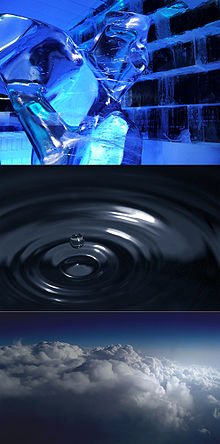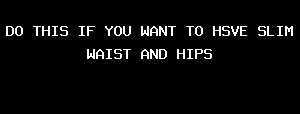Joyfrank
Lab Scientist : Am Still A Student
Wants to meet Laboratory Scientist : Just Want To Meet My Fellow Collegues
Articles
68
Followers
41
profile/92481597753291369.jpg
Joyfrank

Water
~10.4 mins read
This article is about general aspects of water. For a detailed discussion of its physical and chemical properties, see Properties of water. For other uses, see Water (disambiguation).
"H2O" redirects here. For other uses, see Hâ‚‚O (disambiguation).
Water is an inorganic, transparent, tasteless, odorless, and nearly colorless chemical substance, which is the main constituent of Earth's hydrosphere and the fluids of all known living organisms. It is vital for all known forms of life, even though it provides no calories or organic nutrients. Its chemical formula is H2O, meaning that each of its molecules contains one oxygen and two hydrogen atoms, connected by covalent bonds.

Water in three states: solid (ice), liquid and vapor (here mostly invisible water vapor, cooling and condensing, is building clouds).
"Water" is the name of the liquid state of H2O at standard ambient temperature and pressure. It forms precipitation in the form of rain and aerosols in the form of fog. Clouds are formed from suspended droplets of water and ice, its solid state. When finely divided, crystalline ice may precipitate in the form of snow. The gaseous state of water is steam or water vapor. Water moves continually through the water cycle of evaporation, transpiration (evapotranspiration), condensation, precipitation, and runoff, usually reaching the sea.
Water covers 71% of the Earth's surface, mostly in seas and oceans.[1] Small portions of water occur as groundwater (1.7%), in the glaciers and the ice caps of Antarctica and Greenland (1.7%), and in the air as vapor, clouds (formed of ice and liquid water suspended in air), and precipitation (0.001%).[2][3]
Water plays an important role in the world economy. Approximately 70% of the freshwater used by humans goes to agriculture.[4] Fishing in salt and fresh water bodies is a major source of food for many parts of the world. Much of the long-distance trade of commodities (such as oil, natural gas, and manufactured products) is transported by boats through seas, rivers, lakes, and canals. Large quantities of water, ice, and steam are used for cooling and heating, in industry and homes. Water is an excellent solvent for a wide variety of substances both mineral and organic; as such it is widely used in industrial processes, and in cooking and washing. Water, ice and snow are also central to many sports and other forms of entertainment, such as swimming, pleasure boating, boat racing, surfing, sport fishing, diving, ice skating and skiing.
Two hundred years later, Aristotle considered water to be one of four fundamental elements, in addition to earth, air, and fire. The belief that water was a fundamental substance persisted for more than 2,000 years until experiments in the second half of the 18th century showed that water is a compound made up of the elements hydrogen and oxygen.
Two hundred years later, Aristotle considered water to be one of four fundamental elements, in addition to earth, air, and fire. The belief that water was a fundamental substance persisted for more than 2,000 years until experiments in the second half of the 18th century showed that water is a compound made up of the elements hydrogen and oxygen.
The water on the surface of Earth is found mainly in its oceans (97.25 percent) and polar ice caps and glaciers (2.05 percent), with the balance in freshwater lakes, rivers, and groundwater. As Earth’s population grows and the demand for fresh water increases, water purification and recycling become increasingly important. Interestingly, the purity requirements of water for industrial use often exceed those for human consumption. For example, the water used in high-pressure boilers must be at least 99.999998 percent pure. Because seawater contains large quantities of dissolved salts, it must be desalinated for most uses, including human consumption.
This article describes the molecular structure of water as well as its physical and chemical properties. For other major treatments of water, see climate; environmental works; hydrosphere; ice; and pollution.
Structure Of Water
Liquid water
The water molecule is composed of two hydrogen atoms, each linked by a single chemical bond to an oxygen atom. Most hydrogen atoms have a nucleus consisting solely of a proton. Two isotopic forms, deuterium and tritium, in which the atomic nuclei also contain one and two neutrons, respectively, are found to a small degree in water. Deuterium oxide (D2O), called heavy water, is important in chemical research and is also used as a neutron moderator in some nuclear reactors.
water molecule
A water molecule is made up of two hydrogen atoms and one oxygen atom. A single oxygen atom contains six electrons in its outer shell, which can hold a total of eight electrons. When two hydrogen atoms are bound to an oxygen atom, the outer electron shell of oxygen is filled.
freezing points: fresh water and salt water
freezing points: fresh water and salt water
Learn why fresh water and seawater have different freezing points.
Although its formula (H2O) seems simple, water exhibits very complex chemical and physical properties. For example, its melting point, 0 °C (32 °F), and boiling point, 100 °C (212 °F), are much higher than would be expected by comparison with analogous compounds, such as hydrogen sulfide and ammonia. In its solid form, ice, water is less dense than when it is liquid, another unusual property. The root of these anomalies lies in the electronic structure of the water molecule.
The water molecule is not linear but bent in a special way. The two hydrogen atoms are bound to the oxygen atom at an angle of 104.5°.
Structure of the water molecule
showing the two hydrogen atoms bound to the oxygen atom at an angle of 104.5 degrees.
showing the two hydrogen atoms bound to the oxygen atom at an angle of 104.5 degrees.
The O―H distance (bond length) is 95.7 picometres (9.57 × 10−11 metres, or 3.77 × 10−9 inches). Because an oxygen atom has a greater electronegativity than a hydrogen atom, the O―H bonds in the water molecule are polar, with the oxygen bearing a partial negative charge (δ−) and the hydrogens having a partial positive charge (δ+).
structure of the water molecule showing the charges of the hydrogen and oxygen atoms
Hydrogen atoms in water molecules are attracted to regions of high electron density and can form weak linkages, called hydrogen bonds, with those regions. This means that the hydrogen atoms in one water molecule are attracted to the nonbonding electron pairs of the oxygen atom on an adjacent water molecule. The structure of liquid water is believed to consist of aggregates of water molecules that form and re-form continually. This short-range order, as it is called, accounts for other unusual properties of water, such as its high viscosity and surface tension.
water droplets
water droplets
Water is a polar molecule and is attracted to other polar molecules. Thus, droplets, or beads, of water form on a nonpolar surface because water molecules adhere together instead of adhering to the surface.
splitting water
A catalyst that splits water into hydrogen and oxygen.
An oxygen atom has six electrons in its outer (valence) shell, which can hold a total of eight electrons. When an oxygen atom forms a single chemical bond, it shares one of its own electrons with the nucleus of another atom and receives in return a share of an electron from that atom. When bonded to two hydrogen atoms, the outer electron shell of the oxygen atom is filled.
The electron arrangement in the water molecule can be represented as follows.
structure of the water molecule showing the electron arrangement
Each pair of dots represents a pair of unshared electrons (i.e., the electrons reside on only the oxygen atom). This situation can also be depicted by placing the water molecule in a cube.
Water molecule in a cube showing unshared electrons. Hydrogen bonding.
Each ↑↓ symbol represents a pair of unshared electrons. This electronic structure leads to hydrogen bonding.
structure of a water molecule showing unshared electrons, leading to hydrogen bonding
profile/92481597753291369.jpg
Joyfrank

DO THIS IF YOU WANT TO HSVE SLIM WAIST AND HIPS
~9.0 mins read
Its not just about the slim waist and wide hips but when you start exercises and diets to achieve this, it will definitely affect your whole body, change your lifestyle, change your diet....its just like killing two birds with one stone.





So what do you have to do
Studies have shown that it takes your red blood cells 120 days/ three months to regenerate. What it means in simple form is that , when you begin to work on new habits, exercises and positive lifestyle changes on a three month journey, the blood cells your body will regenerate will be based on the activities and diet during the previous three months.
What I am trying to say in essence is that three months is all you need to glow and get that shape you have always wanted. I know it is not as easy as I say it is, it requires your hard work and determination to get results.
Let's get to work
First and foremost, change your diet. Ladies you need to consume not more that 1,500 calories a day to loose one pound a week. So you have to start counting your calorie intake. There are apps that can do that for you, try myfitnesspal
Secondly, you need to get your body moving. It doesn't necessarily mean you should go to the gym, start with normal exercises because you have to break down fat first before building muscles. Simple exercises like walking, running, cycling, using the stairs and jump rope should do the trick
Lastly, build your glutes. Glutes is the general name given to the muscles of the Its not just about the slim waist and wide hips but when you start exercises and diets to achieve this, it will definitely affect your whole body, change your lifestyle, change your diet....its just like killing two birds with one stone.
So what do you have to do
Studies have shown that it takes your red blood cells 120 days/ three months to regenerate. What it means in simple form is that , when you begin to work on new habits, exercises and positive lifestyle changes on a three month journey, the blood cells your body will regenerate will be based on the activities and diet during the previous three months.
What I am trying to say in essence is that three months is all you need to glow and get that shape you have always wanted. I know it is not as easy as I say it is, it requires your hard work and determination to get results.
Let's get to work
First and foremost, change your diet. Ladies you need to consume not more that 1,500 calories a day to loose one pound a week. So you have to start counting your calorie intake. There are apps that can do that for you, try myfitnesspal
Secondly, you need to get your body moving. It doesn't necessarily mean you should go to the gym, start with normal exercises because you have to break down fat first before building muscles. Simple exercises like walking, running, cycling, using the stairs and jump rope should do the trick
Lastly, build your glutes. Glutes is the general name given to the muscle of the butt. Working on those muscles will target your hips and butt. Concerning the slim waist, you have to loose tummy fat first before you can start working on the slim waist.
Here are some of the exercises you can try out for your glutes, stoIts not just about the slim waist and wide hips but when you start exercises and diets to achieve this, it will definitely affect your whole body, change your lifestyle, change your diet....its just like killing two birds with one stone.
So what do you have to do
Studies have shown that it takes your red blood cells 120 days/ three months to regenerate. What it means in simple form is that , when you begin to work on new habits, exercises and positive lifestyle changes on a three month journey, the blood cells your body will regenerate will be based on the activities and diet during the previous three months.
What I am trying to say in essence is that three months is all you need to glow and get that shape you have always wanted. I know it is not as easy as I say it is, it requires your hard work and determination to get results.
Let's get to work
First and foremost, change your diet. Ladies you need to consume not more that 1,500 calories a day to loose one pound a week. So you have to start counting your calorie intake. There are apps that can do that for you, try myfitnesspal
Secondly, you need to get your body moving. It doesn't necessarily mean you should go to the gym, start with normal exercises because you have to break down fat first before building muscles. Simple exercises like walking, running, cycling, using the stairs and jump rope should do the trick
Lastly, build your glutes. Glutes is the general name given to the muscle of the butt. Working on those muscles will target your hips and butt. Concerning the slim waist, you have to loose tummy fat first before you can start working on the slim waist.
Here are some of the exercises you can try out for your glutes, stoIts not just about the slim waist and wide hips but when you start exercises and diets to achieve this, it will definitely affect your whole body, change your lifestyle, change your diet....its just like killing two birds with one stone.
So what do you have to do
Studies have shown that it takes your red blood cells 120 days/ three months to regenerate. What it means in simple form is that , when you begin to work on new habits, exercises and positive lifestyle changes on a three month journey, the blood cells your body will regenerate will be based on the activities and diet during the previous three months.
What I am trying to say in essence is that three months is all you need to glow and get that shape you have always wanted. I know it is not as easy as I say it is, it requires your hard work and determination to get results.
Let's get to work
First and foremost, change your diet. Ladies you need to consume not more that 1,500 calories a day to loose one pound a week. So you have to start counting your calorie intake. There are apps that can do that for you, try myfitnesspal
Secondly, you need to get your body moving. It doesn't necessarily mean you should go to the gym, start with normal exercises because you have to break down fat first before building muscles. Simple exercises like walking, running, cycling, using the stairs and jump rope should do the trick
Lastly, build your glutes. Glutes is the general name given to the muscle of the butt. Working on those muscles will target your hips and butt. Concerning the slim waist, you have to loose tummy fat first before you can start working on the slim waist.
Here are some of the exercises you can try out for your glutes, stoIts not just about the slim waist and wide hips but when you start exercises and diets to achieve this, it will definitely affect your whole body, change your lifestyle, change your diet....its just like killing two birds with one stone.
So what do you have to do
Studies have shown that it takes your red blood cells 120 days/ three months to regenerate. What it means in simple form is that , when you begin to work on new habits, exercises and positive lifestyle changes on a three month journey, the blood cells your body will regenerate will be based on the activities and diet during the previous three months.
What I am trying to say in essence is that three months is all you need to glow and get that shape you have always wanted. I know it is not as easy as I say it is, it requires your hard work and determination to get results.
Let's get to work
First and foremost, change your diet. Ladies you need to consume not more that 1,500 calories a day to loose one pound a week. So you have to start counting your calorie intake. There are apps that can do that for you, try myfitnesspal
Secondly, you need to get your body moving. It doesn't necessarily mean you should go to the gym, start with normal exercises because you have to break down fat first before building muscles. Simple exercises like walking, running, cycling, using the stairs and jump rope should do the trick
Lastly, build your glutes. Glutes is the general name given to the muscle of the butt. Working on those muscles will target your hips and butt. Concerning the slim waist, you have to loose tummy fat first before you can start working on the slim waist.
Here are some of the exercises you can try out for your glutes, stomach and waist :
Advertisement

Link socials
Matches
Loading...
